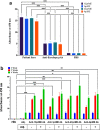Humoral immune response induced with dengue virus-like particles serotypes 1 and 4 produced in silkworm
- PMID: 35102445
- PMCID: PMC8802989
- DOI: 10.1186/s13568-022-01353-6
Humoral immune response induced with dengue virus-like particles serotypes 1 and 4 produced in silkworm
Abstract
Dengue is an arboviral disease, which threatens almost half the global population, and has emerged as the most significant of current global public health challenges. In this study, we prepared dengue virus-like particles (DENV-LPs) consisting of Capsid-premembrane-envelope (CprME) and premembrane-envelope (prME) polypeptides from serotype 1 and 4, which were expressed in the silkworms using Bombyx mori nucleopolyhedrovirus (BmNPV) bacmid. 1CprME, 1prME, 4CprME, and 4prME expressed proteins in hemolymph, and the molecular weight of the purified proteins was 55 kDa, respectively. The purified polypeptides formed spherical Dengue virus-like particles (DENV-LPs) with ~ 30-55 nm in diameter. The immunoelectron microscopy (IEM) images revealed antigens to the surface of a lipid bilayer of DENV-LPs. The heparin-binding assay shows a positive relationship between absorbance and E protein domain III (EDIII) quantity, which is supported by the isothermal titration calorimetry assay. This indicates a moderate binding affinity between heparin and DENV-LP. The high correlation between patient sera and DENV-LP reactivities revealed that these DENV-LPs shared similar epitopes with the natural dengue virus. IgG elicitation studies in mice have demonstrated that DENV-LPs/CPrMEs elicit a stronger immune response than DENV-LP/prMEs, which lends credence to this claim.
Keywords: Capsid; Dengue virus; Dengue virus-like particle; Envelope; Premembrane; Silkworm.
© 2022. The Author(s).
Conflict of interest statement
The authors declare that they have no competing interests.
Figures






Similar articles
-
Production of dengue virus-like particles serotype-3 in silkworm larvae and their ability to elicit a humoral immune response in mice.AMB Express. 2020 Aug 17;10(1):147. doi: 10.1186/s13568-020-01087-3. AMB Express. 2020. PMID: 32804287 Free PMC article.
-
Formation of Virus-Like Particles of the Dengue Virus Serotype 2 Expressed in Silkworm Larvae.Mol Biotechnol. 2019 Nov;61(11):852-859. doi: 10.1007/s12033-019-00210-5. Mol Biotechnol. 2019. PMID: 31473916
-
Virus-like particles derived from Pichia pastoris-expressed dengue virus type 1 glycoprotein elicit homotypic virus-neutralizing envelope domain III-directed antibodies.BMC Biotechnol. 2016 Jun 14;16(1):50. doi: 10.1186/s12896-016-0280-y. BMC Biotechnol. 2016. PMID: 27301568 Free PMC article.
-
Antibody-Dependent Enhancement: A Challenge for Developing a Safe Dengue Vaccine.Front Cell Infect Microbiol. 2020 Oct 22;10:572681. doi: 10.3389/fcimb.2020.572681. eCollection 2020. Front Cell Infect Microbiol. 2020. PMID: 33194810 Free PMC article. Review.
-
The human antibody response to dengue virus infection.Viruses. 2011 Dec;3(12):2374-95. doi: 10.3390/v3122374. Epub 2011 Nov 25. Viruses. 2011. PMID: 22355444 Free PMC article. Review.
Cited by
-
Display of multiple proteins on engineered canine parvovirus-like particles expressed in cultured silkworm cells and silkworm larvae.Front Bioeng Biotechnol. 2023 Feb 16;11:1096363. doi: 10.3389/fbioe.2023.1096363. eCollection 2023. Front Bioeng Biotechnol. 2023. PMID: 36873345 Free PMC article.
-
Overcoming dengue vaccine challenges through next-generation virus-like particle immunization strategies.Front Cell Infect Microbiol. 2025 Jun 16;15:1614805. doi: 10.3389/fcimb.2025.1614805. eCollection 2025. Front Cell Infect Microbiol. 2025. PMID: 40589870 Free PMC article. Review.
-
An Overview of Recent Developments in the Application of Antigen Displaying Vaccine Platforms: Hints for Future SARS-CoV-2 VLP Vaccines.Vaccines (Basel). 2023 Sep 20;11(9):1506. doi: 10.3390/vaccines11091506. Vaccines (Basel). 2023. PMID: 37766182 Free PMC article. Review.
References
Grants and funding
LinkOut - more resources
Full Text Sources

